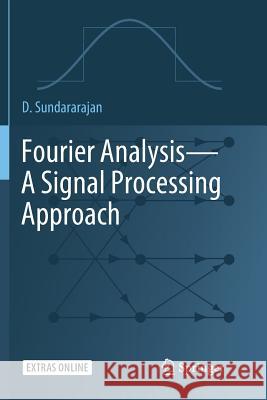Fourier Analysis--A Signal Processing Approach » książka



Fourier Analysis--A Signal Processing Approach
ISBN-13: 9789811346651 / Angielski / Miękka / 2019 / 359 str.
Fourier Analysis--A Signal Processing Approach
ISBN-13: 9789811346651 / Angielski / Miękka / 2019 / 359 str.
(netto: 275,36 VAT: 5%)
Najniższa cena z 30 dni: 287,12 zł
ok. 20 dni roboczych.
Darmowa dostawa!
"The Fourier analysis is mainly presented from a practical point of view, where the mathematical theory is very simplified. This book is mainly written for broad readership of graduate students and researchers in physics, computer science, and engineering with special interest in signal processing. ... Doubtless, this textbook will stimulate the practical education in the Fourier analysis and its applications in signal processing." (Manfred Tasche, zbMATH 1407.94002, 2019)
Contents
Dr. D. Sundararajan holds a B.E. in Electrical Engineering from Madras University and an M.Tech. in Electrical Engineering from the Indian Institute of Technology Chennai (IIT Chennai). He obtained his Ph.D. in Electrical Engineering at Concordia University, Montreal, Canada in 1988. As the principal inventor of the latest family of discrete Fourier transform (DFT) algorithms, he holds three patents (granted by the US, Canada and Britain). Further, he has published several papers in IEEE Transactions and in the Proceedings of the IEEE Conference, and he is the author of five books. He has taught undergraduate and graduate classes in digital signal processing, digital image processing, engineering mathematics, programming, operating systems and digital logic design at Concordia University, Canada, Nanyang Technological University, Singapore, and Adhiyamaan College of Engineering, India. He has also conducted workshops on Digital image processing, MATLAB and LaTeX.
Over the course of his engineering career, he has held positions at the National Aerospace Laboratory, Bangalore, and the National Physical Laboratory, New Delhi, where he worked on the design of digital and analog signal processing systems.
This book sheds new light on Transform methods, which dominate the study of linear time-invariant systems in all areas of science and engineering, such as circuit theory, signal/image processing, communications, controls, vibration analysis, remote sensing, biomedical systems, optics and acoustics. It presents Fourier analysis primarily using physical explanations with waveforms and/or examples, only using mathematical formulations to the extent necessary for its practical use. Intended as a textbook for senior undergraduates and graduate level Fourier analysis courses in engineering and science departments, and as a supplementary textbook for a variety of application courses in science and engineering, the book is also a valuable reference for anyone – student or professional – specializing in practical applications of Fourier analysis. The prerequisite for reading this book is a sound understanding of calculus, linear algebra, signals and systems, and programming at the undergraduate level.
1997-2024 DolnySlask.com Agencja Internetowa
KrainaKsiazek.PL - Księgarnia Internetowa









